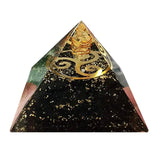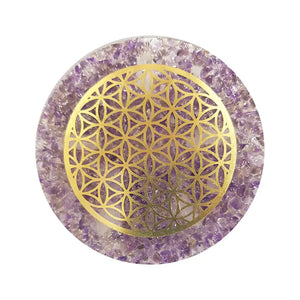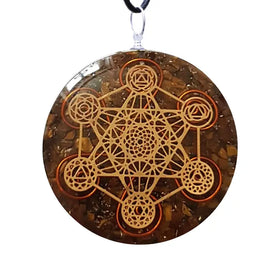1) Extrasensory experience
Mystics believe that their experiences reveal the existence of an extrasensory dimension of reality: phenomena whose existence cannot be detected by sense perception become apparent during mystical experience . Mystics differ radically, however, in their claims about extrasensory realities. When mystics make claims about extrasensory dimensions of reality , they are making the same type of claim as physicists when citing the laws of physics or psychologists when positing emotional complexes that govern healthy responses. and morbid to the events. They're not about magic, mythology , or another world; they attempt to speak, equally or inaccurately, about aspects of the world of sense perception that are not perceptible by the senses. mystical experiences , extrasensory phenomena are said to be directly perceived, whether by the soul, mind, imagination, or some other faculty. The phenomena that mystics encounter may be impersonal - for example, a unifying principle, structure, process, law or force - or personal - for example, ghosts, spirits, angels, demons or gods or revelations derived from these personal beings. The inclusion of both impersonal and personal phenomena in the extrasensory is reflected in the medieval description of the extrasensory as "spiritual", a usage which is reflected in the meaning of the German word Geist ("intellect" or "spirit") ).
VIDEO
2) Understand the spiritual
For mystics , the spiritual is not only something to think about, but also something to encounter. Spiritual phenomena can be said to be experienced when they are thought of in such a way that a depth of feeling is attached to them. When the experience of the spiritual is sincere, the spiritual reveals itself to be mysterious, awe-inspiring, urgent, and fascinating – what the German theologian and historian of religion Rudolf Otto called “numinous.” spirituality and the numinous is comparable to the relationship between a beautiful object and someone's aesthetic experience of the object. A work of art can at some times be experienced as beautiful and at other times be experienced as boring or even ugly. Its beauty – that is, its potential to be experienced as beautiful – exists whether the work of art is momentarily appreciated as beautiful. Likewise, the physical circumstances used to define the physical laws of motion exist whether or not objects instantiate them at any given time. Analogously, the spiritual exists and can even be known to be spiritual, whether or not it is momentarily appreciated as numinous.
Shamans and other mystics embrace pantheons that define the scope of the spiritual, partly by inference from the perceptible world and partly through mythology.
Ancient thinkers of the Platonic tradition subjected the spiritual to philosophical inquiry. While validating the contemplation of intelligibles (extrasensory objects or phenomena), they divided visions into metaphorical expressions of intelligibles on the one hand and unreliable fantasies on the other. In both cases, the visions were seen as imaginative combinations of memories of sense perceptions .
In the later Aristotelian tradition of rational mysticism , the spiritual was discovered through meditation on nature. Following the 4th century theologians Evagrius Ponticus and John Cassian, Christian mystics allowed themselves only a very reduced program. They contemplated both the intelligible power of God in the world and God himself, but they avoided visions on the grounds that reliable visions were too easy for demons to counterfeit.
The visions were rehabilitated in Islam as early as the 10th century and in Christianity and Judaism in the 12th century. In all cases, the contemplation of intelligibles was considered more reliable and desirable than the experience of visions.
The problem of discerning the truly spiritual has also been addressed in Asian religions. In Taoism , visions are favored because the human microcosm contains the same constituent components as the cosmos, and contemplation of the cosmos has reliable implications regarding the Dao as a whole. Hinduism and Buddhism instead share an absolute skepticism that rejects both materiality and almost all spirituality as maya ("illusion"). For Hindus, the solitary exception to maya is spirit in its most abstract form. As noted above, Hindu mystics locate truth beyond illusion either dualistically, in pure purusha (“spirit”) – as opposed to the illusion of prakriti (“matter”) – or non-dualistic, as a monistic substance sat-cit-ananda (“being-consciousness-bliss”). Buddhist mystics even reject these claims. Their meditations classically address a series of eight jhanas (Pali: "meditations"). The first four have forms that can be imagined or envisaged, and the last four are formless and result in "neither perception nor non-perception." Thus, from a comparative perspective, one can conclude that because worldly mystics make contradictory claims regarding the spiritual, a component of fantasy likely complicates the perception of the extrasensory.
3) Transcend the spiritual The aspiration of Buddhist meditation to transcend the whole spiritual represents an option that many mystical schools have taken. Western mysticism's perception of God as totally transcending both material and spiritual creation has led to descriptions of him as the ineffable, the infinite, the God beyond being, the God beyond being. being and non-being, and the God whose essence can never be known. Mystics in these traditions claim that their experiences are limited to the spiritual; it is these experiences, however, that convince them that the spiritual was created and transcended by God. mystical traditions consider similar ideas, only to disassociate themselves from them. The Daodejing, the great work of Chinese philosophy composed around 300 BCE, begins with the assertion that the Dao which cannot be named is equivalent to the Dao which can be named. The unnameable and ineffable Father is totally transcendent, and the nameable Mother manifests everywhere. Although the father and mother are radical opposites, the two are one. Christian mystics generally extend the doctrine of the Incarnation of God in the man Jesus to express a more general concern for the omnipresence of the Word in all creation. The transcendent Father can only be known through the Son (the omnipresent Word); yet, with the Holy Spirit, they form a single divinity which is immanent everywhere. An equivalent paradox is adopted by Mahayana Buddhists , who speak of phenomenal reality as shunyata (Sanskrit: "void" or "void"). According to them, the immanent is empty because it also transcends itself.radical transcendence impersonally or as an attribute of God, mystical experiences themselves are always limited to the spiritual and do not include contact with the transcendent. During mystical experiences, spiritual phenomena may appear as ultimate, self-existent, and divine or may be experienced as contingent. Spiritual phenomena are then not considered self-existent but rather attest to a superior role of a creator who transcends them. A distinction is then made between the spiritual and the divine, and mystics are content to deduce the divine from experiences of the spiritual.
4) Mysticism and secrecy
Living the hidden
Because mystics experience spiritual phenomena that are hidden from the senses, the physical world revealed through sense perception does not exhaust reality as mystics understand it. Some mystics find the spiritual to be immanent in the world of ordinary sense perception, but others dismiss the perceptible world as illusion and attribute reality to the spiritual alone. Whatever the precise detail of the relationship of the extrasensory to the perceptible, the concealment of spirituality is an important feature of mysticism. Hindu yogis, Buddhist meditators, and Christian mystics have attempted, wherever possible, to be exclusively spiritual, abstaining from material possessions and the satisfaction of bodily needs and withdrawing from human society and the world entire physical existence . Other approaches, however, are less extreme.The analytical psychologist Carl Jung suggested the term mysterium coniunctionis (Latin: "mystery of conjunction") as a designation for mystical paradoxes. Mystics who conceptualize a mysterium coniunctionis—and not all of whom do—find it difficult to put the paradox into words, both in their own thoughts and in interpersonal communications. Words allow us to arrive at the paradox. For example, the statement "A and B are one" uses the non-paradoxical concepts "A", "B" and "one". Each of the non-paradoxical concepts can be explained separately. However, the concepts are juxtaposed in such a way that the sentence as a whole results in a concept of "one" that is not its usual meaning, and it can be extremely difficult to find words that express the paradox at greater length by articulating nuances, implications, corollaries, etc.
The practice of secrecy Because mystics experience spiritual phenomena that are hidden from the senses, they often conform to the secret of the spiritual by being secret themselves. Some mystics withdraw into silence. Some keep their ecstatic experiences secret but speak openly about their mystical ideas and beliefs . Others are even less secret, retaining, for example, only a certain technique by which alternative states of consciousness are achieved, such as a doctrine, a song or a spiritual name. In many Native American cultures, people were expected to seek visions in order to encounter a guardian spirit who would bestow a song or name by which a lesser spirit could be acquired as help. The song or name was kept secret, so that no one else had access to the power it bestowed, and in most cases the contents of the vision were only reported to the person teaching to the visionary. In this way, the concealment of the spiritual was imitated by the visionaries and their communities. In several traditional African cultures, boys approaching puberty were taken from their villages into the forest, where they lived in a boys' village for two or three years. During this period, they learned secret traditions and underwent ritual induction of a mystical experience through the administration of a psychoactive drug . After the initiation , the young people returned to the communal villages and continued outwardly as if no secrets existed.
In many other cultures, people are initiated into secret societies through mystical practice. In other cases, initiation into a mystical practice defines a social class. For example, a successful vision quest was a condition of men's eligibility to join a hunting party in many Native American cultures. Elsewhere, initiations were essential for participation in warrior groups and militias and in casual occupations, such as ironsmithing. In classical Greece and the Hellenistic world, initiation rites were undergone for the purpose of having mystical experiences and gaining knowledge of the mysteries . Secret societies, often with political agendas, have been a major feature of Taoism for nearly 2,000 years and have been characteristic of Western esotericism since the Renaissance. coded languages that are not understood by the tradition's laity. Shamans transmit secret meanings to each other using vocabularies composed of archaic words and metaphors. Taoism similarly uses coded language , a fact that makes many parts of Taoist texts incomprehensible to the uninitiated. The "intentional languages" of Hindu and Buddhist tantric texts include vocabularies in the names of common objects that are intentionally used in covert ways to speak of visionary and mystical experiences . In his seventh letter, Plato claimed that his writings contain allusions to secret teachings ; and the Babylonian Talmud , a compilation of Jewish teachings and commentaries, teaches that Jewish mysticism should be taught only by means of "chapter headings." The symbols ("symbols") of the Pythagoreans, the ciphers of the Western alchemists , the taʾwil (allegorical interpretations) of the Sufi mystics, and the exegetical technique of the turf ("secret") Kabbalists are later developments of the practice of coded languages among Mystics Westerners.Hinduism, Buddhism, and the early Christian Gnostic movement , mystical secrecy includes the devaluation of phenomenological reality as "unreal." The divine is seen as a keeper of secrets , who deceives and mocks humanity, condemning it to suffering through ignorance. In other mystical systems, perceptible reality is considered not a deception but a code that a mystic can learn. Syrian Christian mysticism considers physical phenomena as symbols of higher spiritual realities. The Neoplatonic tradition, which underlies Sufism, Kabbalah, and Western esotericism , views physical phenomena as lower manifestations of spiritual realities at higher levels of being. In the 16th century, the Dutch mystic Jakob Böhme wrote of "the signature of all things." The correspondence of the cosmos with the human body in Taoism and Tantric mysticism allows the two orders of reality to be encoded in terms of gods, landscape, elements, various mineral and plant substances, etc...
5) Mystical states
Trance
Mystical experiences can be classified not only according to their content, but also according to the alternative states of consciousness during which they occur. For example, Saint Teresa of Ávila distinguished four stages of mystical prayer . In “the prayer of simplicity,” a prayer of approximately one sentence is repeated continually until other thoughts cease to follow in orderly succession. As thought stops, prayer reaches a point called “ligation” or “suspension,” when external reality is much less distracting. The second stage of the prayer, “the prayer of calm,” begins at the beginning of the ligature. During this stage, repetitive prayer continues to require conscious effort, but it gradually ceases to be a voluntary meditation and instead becomes an involuntary, passively experienced object of contemplation. When the increasing forgetfulness of external reality and preoccupation with contemplation reaches such a magnitude that distractions cease to intrude into consciousness entirely, the prayer of calm has ended and " the prayer of full mystical union " would have begin. Efforts to avoid distraction and maintain contemplation are now almost useless. Sense perception is half suspended; the sense of hearing is the last of the senses to be inhibited. The simultaneous increase in ligature and contemplation is again gradual, arriving in increments at the final stage of the Roman Catholic mystical experience, which St. Teresa described in terms of three categories. “Ecstasy” appears gradually or quietly. “Rapture” is an experience of the same content when its onset is violent and sudden. Finally, the “flight of the soul” is a rapture with the specific content of an out-of-body experience.mystical trances can be experienced as real and true. Ideas become illusions; daydreams become hallucinations. Trances therefore promote forms of religiosity that are at least partly incompatible with a scientific understanding of the perceptible world.
Reverie However, not all mysticism has its basis in trance states . Rudolf Otto noted this fact when he proposed a dualistic classification of numinous experiences . In the mysterium tremendum (“fear-inspiring mystery”), the numinous is experienced as mysterious, impressive and urgent. Otto identified the other class of experiences, in which the numinous is fascinating ("fascinating"), with the "Dionysian element ", as defined by the German philosopher Friedrich Nietzsche. This allusion to the chaotic, creative, spontaneous, and irrepressible element of the unconscious implied that the mysterium tremendum was the Apollonian element—ordered, controlling, rationalistic, and conscious. visions are experienced as revelations rather than as perceptions of external realities. The content of visions is often symbolic or allegorical and requires proper interpretation to be understood. Unitive experiences are also thought to be metaphors and not literal truths.trances and reveries and can differ little more than the reification and preternaturalism that trance brings. The experience that everything is one, for example, can lead in trance to a denial of the reality of physical plurality, while in reverie it can lead to wonder at something like the periodic table of atomic elements, which attests to an underlying physical unity. reality. In trance, the all-in-one is reified, so the plurality cannot be real; in reverie, the all-in-one is obviously a metaphor and speaks of an extrasensory dimension of the physical. The idea of dying can manifest itself during a daydream as a "mystical death" experience, a rare case where the daydream has the quality of a mysterium tremendum. Vivid hallucinatory fantasies of being about to die, about to die, or of being dead can cause extreme panic, which ends with the realization that life goes on. During a trance, the idea of dying can take a visionary form as an out-of-body experience in which the visionary outlives the body by leaving it. Reverie and trance accommodate other disturbing materials in similar ways, the disturbances being felt in reverie and inhibited or desired in trance. Mystics may interpret reverie states as if they were trance states, resulting in an attitude toward visions that the French historian of religion Henry Corbin described as "imaginary." Mystics can also interpret trance states as if they were daydreams.
VIDEO
Ancient and Hellenistic philosophers offered three examples of the reality of the extrasensory : the numbers and mathematical formulas of Pythagoras; the ideas of Plato and the universals (substantial and accidental forms) of Aristotle; and the Stoic concept of the lekton, or “saying.”
Thus, a number or mathematical formula exists or is true objectively, whether or not it is known to anyone. It is an intelligible or thinkable reality, but not sensible or perceptible. The Aristotelian concept of universals is constructed in the same way from the sensory evidence of things to the concepts about these things to the concept of conceptual things. Red, yellow and blue things can be seen through the operation of the senses; the ideas of red, yellow and blue can be conceptualized through abstraction. The subsequent abstraction – the concept of color – no longer pertains to anything sensory but concerns an extrasensory phenomenon , color in general or color in the abstract. The meaning or meaning of a vocal sound (a word or phrase) is also extrasensory but again completely real.
All laws of nature describe the interactions or relationships between perceptible things. The relationships are intelligible or thinkable; they are not themselves sensitive or perceptible. When, for example, Newton's third law of motion (that interacting bodies apply forces to each other that are equal in magnitude and opposite direction) is illustrated by the collision of two moving objects, sensory perception sees objects approach, come into contact and separate. It is the mind or intellect that conceptualizes the processes of action and reaction, equality and opposition, and perhaps attraction and repulsion . The realities operating in emotional relationships are equally extrasensory. Psychological phenomena such as honor and revenge are perceived by the mind, rather than the senses, through the abstraction of very complex and potentially variable physical interactions.

































